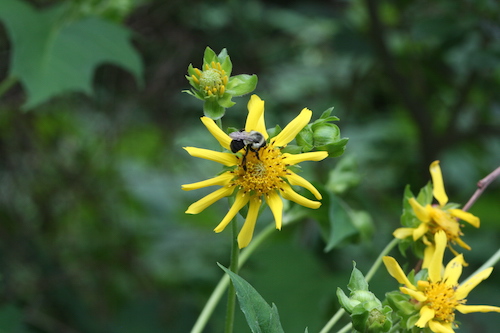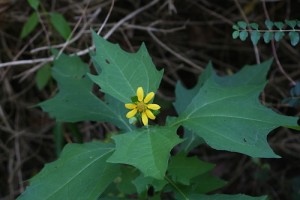Leafcup – July 2015 Wildflower of the Month
 Smallanthus uvedalia. This is a large, coarse plant growing 3-10 feet tall on stems that are often hairy. Huge leaves, to over a foot long, are cut into several lobes and somewhat resemble the foot of a bear, suggesting the other common name “Bearsfoot.” The plant is usually known as “Leafcup” because the leaves are arranged in pairs on the stems, and the petiole of each leaf is winged, forming a small cup around the stem.
Smallanthus uvedalia. This is a large, coarse plant growing 3-10 feet tall on stems that are often hairy. Huge leaves, to over a foot long, are cut into several lobes and somewhat resemble the foot of a bear, suggesting the other common name “Bearsfoot.” The plant is usually known as “Leafcup” because the leaves are arranged in pairs on the stems, and the petiole of each leaf is winged, forming a small cup around the stem.
 Each plant is covered with yellow flowers, 1-3 inches across, visited by many butterflies, bees, wasps, and other insects. Leafcup is a member of the Aster Family, with tiny flowers crowded into the central disk, surrounded by yellow rays. Aster flowers are complex – the anthers (male reproductive part) are packed into a cylinder and as they mature, the pistil (female reproductive part) is pushed up through the cylinder, presenting pollen grains to insects seeking nectar. After a few days, when the pollen grains are no longer viable, the stigma opens and becomes receptive to the pollen deposited by other visiting insects. The large seeds resulting from fertilization are food for many species of birds.
Each plant is covered with yellow flowers, 1-3 inches across, visited by many butterflies, bees, wasps, and other insects. Leafcup is a member of the Aster Family, with tiny flowers crowded into the central disk, surrounded by yellow rays. Aster flowers are complex – the anthers (male reproductive part) are packed into a cylinder and as they mature, the pistil (female reproductive part) is pushed up through the cylinder, presenting pollen grains to insects seeking nectar. After a few days, when the pollen grains are no longer viable, the stigma opens and becomes receptive to the pollen deposited by other visiting insects. The large seeds resulting from fertilization are food for many species of birds.
Leafcup is native to nearly every county in Virginia, and ranges from New York to Illinois and Missouri, south to Florida and Texas. This large perennial grows best in part shade, in soil that remains moist in the summer. It can be seen in native woodlands at the edge of forest, in shade filtered by the leaves of the forest trees. Because of its size, this plant is suitable for the back of a perennial border, or edges of woods.
Native Americans used extracts of the root of Bearsfoot as a stimulant and laxative. Physicians in the late 1800’s recommended its use in ointments for ailments such as rheumatism, swellings, fevers, burns, cuts and local inflammations.
By Helen Hamilton, past-president of the John Clayton Chapter, VNPS
Photos: Leafcup (Smallanthus uvedalia) taken by Helen Hamilton
